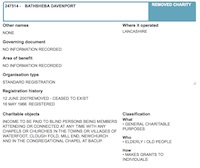52 residents #10 Bathsheba Davenport
06/03/15 17:00
At last.
Bathsheba Davenport was born c 1796 in Manchester. She is listed in Slater’s Northern directory 1848 as Bathsheba Davenport as milliner in Newchurch.
On the 1851 census she is residing with her younger sister, Sarah, in Newchurch
Mannex 1854 states Rebecca Davenport, milliner, Newchurch
She was obviously a lady of some substance, owning stocks in the Liverpool Consolidated Gaslight Company, Shares in the Manchester and Liverpool District Banking Company and rental income from property on Coverdale St, Hamlet St, Emma St and Railway View in Ardwick, Manchester.
She died on 4 Sept 1893 and her will is fascinating.
She starts with the usual naming of executors with a legacy to each and a legacy to her nieces and nephews from the proceedings of her investments. Then follows a legacy to the children of her niece or nephews if any should happen to be blind, for as long as they remain blind. If none should be blind then the money is to go to blind people associated with the Chapels and Churches of Cloughfold, Mill End, Newchurch and Waterfoot and the congregational Chapel at Newchurch. There obviously were no blind family members as Bathsheba’s trust was mentioned in the Lancashire VCH entry for Newchurch in the above terms. The charity was registered with the charities commission in 1966 and removed in 2007 with income of £50. I don’t know if they ever paid out.

In addition there were a number of personal bequests in a codicil, many amended during drafting, including pictures of Mr and Mrs Gladstone with frames to one great nephew (gee, thanks) and her underclothing in equal shares to her two nieces (ditto - one take the bras and the other the knickers?) plus £5 to a couple of nonconformist ministers, one of whose names she did not know.
The blind bit got me thinking - reversible causes of blindness in the 19th century? There are a number of medical conditions of which blindness is a symptom which reverses at the condition improves but many of these were not treatable in C19. Many of today’s causes are preventable or treatment stops progression rather than truly reversible. So that leave us with cataracts, corneal scarring and retinal detachment to some extent.
Cataract surgery was first performed in 1746 and Freud and Koller’s later work on local anaesthesia was in part to facilitate this - Freud became a psychoanalyst and Koller a cocaine addict. corneal transplant was first attempted in 1838 although not successful before 1905. Retinal detachment surgery was rare before 1900 and rarely successful before the 1920s.
It appears therefore that Bathsheba’s stipulations came at a time when correction of blindness was, in some cases, beginning to become a reality. Did a spinster milliner in Newchurch have any idea of this?
Bathsheba Davenport was born c 1796 in Manchester. She is listed in Slater’s Northern directory 1848 as Bathsheba Davenport as milliner in Newchurch.
On the 1851 census she is residing with her younger sister, Sarah, in Newchurch
Mannex 1854 states Rebecca Davenport, milliner, Newchurch
She was obviously a lady of some substance, owning stocks in the Liverpool Consolidated Gaslight Company, Shares in the Manchester and Liverpool District Banking Company and rental income from property on Coverdale St, Hamlet St, Emma St and Railway View in Ardwick, Manchester.
She died on 4 Sept 1893 and her will is fascinating.
She starts with the usual naming of executors with a legacy to each and a legacy to her nieces and nephews from the proceedings of her investments. Then follows a legacy to the children of her niece or nephews if any should happen to be blind, for as long as they remain blind. If none should be blind then the money is to go to blind people associated with the Chapels and Churches of Cloughfold, Mill End, Newchurch and Waterfoot and the congregational Chapel at Newchurch. There obviously were no blind family members as Bathsheba’s trust was mentioned in the Lancashire VCH entry for Newchurch in the above terms. The charity was registered with the charities commission in 1966 and removed in 2007 with income of £50. I don’t know if they ever paid out.

In addition there were a number of personal bequests in a codicil, many amended during drafting, including pictures of Mr and Mrs Gladstone with frames to one great nephew (gee, thanks) and her underclothing in equal shares to her two nieces (ditto - one take the bras and the other the knickers?) plus £5 to a couple of nonconformist ministers, one of whose names she did not know.
The blind bit got me thinking - reversible causes of blindness in the 19th century? There are a number of medical conditions of which blindness is a symptom which reverses at the condition improves but many of these were not treatable in C19. Many of today’s causes are preventable or treatment stops progression rather than truly reversible. So that leave us with cataracts, corneal scarring and retinal detachment to some extent.
Cataract surgery was first performed in 1746 and Freud and Koller’s later work on local anaesthesia was in part to facilitate this - Freud became a psychoanalyst and Koller a cocaine addict. corneal transplant was first attempted in 1838 although not successful before 1905. Retinal detachment surgery was rare before 1900 and rarely successful before the 1920s.
It appears therefore that Bathsheba’s stipulations came at a time when correction of blindness was, in some cases, beginning to become a reality. Did a spinster milliner in Newchurch have any idea of this?




